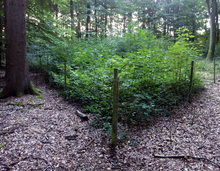Vegetation report

Vegetation reports , also dogged reports or official in Bavaria Forstliches report on the situation of forest rejuvenation called summarize the data collected in the course of rejuvenation inventories on the status of forest regeneration, as well as its influence on the by ungulates z together and give. Sometimes also recommendations for the height of the kills in hoofed game.
Background and purpose
In particular, browsing of the main shoots by game, but also sweeping damages the young forest trees. In addition, older trees can be affected by deer peeling . In the case of high hoofed game densities , the damage caused by game can lead to the fact that tree species such as the fir or oak tree that have been particularly bitten can fail completely and the forest regeneration is segregated. In the long term, this leads to unstable and damage-prone pure stands, such as spruce monocultures.
The vegetation reports are intended to systematically record the state of forest regeneration and the influence of game and thus provide a database on which the responsible actors, in particular forest owners , state forest and hunting authorities and those authorized to hunt, can plan the shooting of hoofed game.
Germany
In Germany, the forest authorities of the states of Baden-Württemberg, Bavaria, Brandenburg, Hesse, Mecklenburg-Western Pomerania, Rhineland-Palatinate, Saxony and Thuringia regularly prepare vegetation reports. The forestry reports are drawn up at the level of the hunting grounds or management communities and assess the damage caused by browsing, sweeping and peeling.
Bavaria
The forestry reports on the situation of forest regeneration in Bavaria have been prepared every three years by the lower forest authorities for the around 750 Bavarian management communities since 1986 and have also included statements for the individual hunting grounds as well as additional evaluations of the regeneration inventory since 2012. The reports are drawn up in a two-stage system. At the beginning of the growing season in spring, the forest officials carry out an inventory of the regeneration situation on over 25,000 systematically selected regeneration areas . During the inventory, the young plants of the forest trees are recorded in sample circles and examined for browsing and sweeping damage by hoofed game.
On the basis of the results of this statistically secured random sample inventory and other findings, such as for example of patrols with forest owners and hunters or of meadow areas, the experts of the Bavarian Forest Administration then prepare the forestry report for the management community. The browsing situation is assessed in four stages (browsing load "favorable", "acceptable", "too high" or "significantly too high") and a shooting recommendation for the coming three-year shooting plan period is made ("significantly lower", "lower", "retained" "," Increase "or" increase significantly ").
The forestry reports are made available to the relevant boards of the hunting cooperatives , owner- hunted owners , district tenants, lower hunting authorities and hunting boards in advance of the three-year shooting plan for roe deer. In the process the Forest reports are hunting companions and hunters closely involved, so they can participate in the inventory record and comment on the results of rejuvenation inventory.
In forest science, the procedure for the Bavarian vegetation report is received positively because it "objectively selects representative regeneration areas and carefully measures the browsing there with the help of a suitable indicator." With the introduction of the forest report in 1986 as an objective basis, this often became very emotional The discussion between hunters and forest owners about browsing damage and shooting plan heights should be made more objective.
Austria
In Austria, the nationwide wildlife impact monitoring (WEM) has been carried out with uniform guidelines since 2004.
Sweat
The Swiss cantons use different methods to assess game damage.
Web links
Individual evidence
- ↑ a b Thomas Knoke , Torsten Hothorn, Reinhard Mosandl, Eckhard Kennel: Browsing reports paint a realistic picture. In: waldwissen.net. March 3, 2013, archived from the original on December 11, 2018 ; accessed on December 11, 2018 .
- ↑ Christian Ammer , Torsten Vor, Thomas Knoke, Stefan Wagner: The forest-wild conflict. Analysis and solution approaches against the background of legal, ecological and economic relationships . In: Göttingen Forest Sciences . tape 5 . Göttinger Universitätsverlag, Göttingen 2010, ISBN 978-3-941875-84-5 , p. 112 .
- ↑ Preier, P .: game impact monitoring WEM. In: BFW. December 4, 2013, archived from the original on December 11, 2018 ; accessed on December 11, 2018 .
- ↑ Oswald Odermatt: Results from studies on the influence of wildlife on forest regeneration in Switzerland. In: waldwissen.net. November 15, 2012, archived from the original on December 11, 2018 ; accessed on December 11, 2018 .